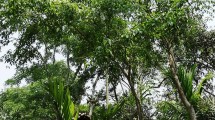Abstract
Nectarine is an important stone fruit after plum and peach. The area under peach cultivation is now getting replaced by nectarine due to its fuzzless nature and high nutritive value. Nectarines are juicy, delicious fruits having low calorific value and have high antioxidant capacity. In India, its cultivation is confined to North-Western and North-Eastern Himalayas. In this study, five major nectarine cultivars growing in India namely, ‘Silver Queen’, ‘Red Gold’, ‘Spring Bright’, ‘Independence’ and ‘Missourie’ were harvested at commercial maturity and analyzed for various chemical and nutritional aspects. Our results showed that there were quantitative differences among the genotypes in different parameters analyzed. The predominant sugar in nectarine was fructose which was highest in ‘Silver Queen’ (14.48 mg 100 g−1 FW) and lowest in ‘Independence’ (9.04 mg 100 g−1 FW). Major organic acids were malic, succinic, citric and acetic acid. The highest malic acid content was recorded in ‘Independence’ (1.13 mg 100 g−1 FW) and lowest in ‘Red Gold’ (0.61 mg 100 g−1 FW). Nectarine genotypes chiefly contained phloridizin dihydrate and chlorogenic acid as the phenolic component. However, chlorogenic acid was highest in ‘Spring Bright’ (17.63 µg g−1 FW) and lowest in ‘Red Gold’ (3.67 µg g−1 FW). Similarly, a wider variability was recorded in major and minor mineral concentrations among the genotypes. Based on these observations, it can be concluded that among the major nectarine varieties cultivated in India, ‘Silver Queen’ have higher mineral nutrients than other varieties, and ‘Spring Bright’ have higher phenolics and antioxidants.

Similar content being viewed by others
Abbreviations
- CUPRAC:
-
Cupric reducing antioxidant capacity
- FRAP:
-
Ferric reducing ability of plasma
- HPLC:
-
High performance/pressure liquid chromatography
- µg g−1 :
-
Microgram per gram
- ROS:
-
Reactive oxygen species
References
Abidi W, Jiménez S, Moreno MA, Gogorcena Y (2011) Evaluation of antioxidant compounds and total sugar content in a nectarine progeny. Int J Mol Sci 12:6919–6935
Adrees M, Younis M, Farooq U, Hussain K (2010) Nutritional quality evaluation of different guava varieties. Pak J Agric Sci 47:1–4
A.O.A.C. (2000) Official methods of analysis, 17th edn. Association of Official Analytical Chemists, Washington, DC
Apak R, Guclu K, Ozyurek M, Karademir SE (2004) Novel total antioxidants capacity index for dietary polyphenol and vitamins C and E using their cupric ion reducing capability in the presence of neocuprine: CUPRAC method. J Agric Food Chem 52:7970–7981
Aziz M, Jadoon S, Ziviqar S (2013) Apple pulp (Pyrus malus) nutritional profiling and evaluation of various varieties of Balochistan. Pak J Nutr 12(3):239–243
Benzie IFF, Strain JJ (1996) The ferric reducing ability of plasma as a measure of antioxidant power: the FRAP assay. Anal Biochem 239:70–76
Boyer J, Liu RH (2004) Apple phytochemicals and their health benefits. Nutrition 12:3–5
Colaric M, Robert V, Stampar F, Hudina M (2005) Evaluation of peach and nectarine fruit quality and correlations between sensory and chemical attributes. J Sci Food Agric 85(15):2611–2616
Fazli AF, Fazli NA (2014) Evaluation and determination of mineral contents in fruits. Int J Plant Anim Environ Sci 4(2):160–166
Gil MI, Tomas F, Betty BA, Pierce H, Kader AA (2002) Antioxidant capacities, phenolic compounds, carotenoids, and vitamin C contents of nectarine, peach, and plum cultivars from California. J Agric Food Chem 50:4976–4982
Kelebek H, Selli S, Canbas A, Cabaroglu T (2009) HPLC determination of organic acids, sugars, phenolic compositions and antioxidant capacity of orange juice and orange wine made from a Turkish cv. Kozan. Microchem J 91:187–192
Milošević T, Milošević N, Glišić I (2012) Evaluation of fruit growth and postharvest physical and chemical properties of nectarine [Prunus persica var. nectarina (Ait.) Maxim.]. Acta Sci Pol Hortorum Cult 11(5):17–30
Panse VG, Sukhatme PV (1984) Statistical methods for agricultural workers, 3rd edn. Indian Council of Agricultural Research, New Delhi
Ranganna S (1999) Handbook of analysis and quality control for fruits and vegetable Products, 2nd edn. Tata McGraw-Hill Publishing Company Ltd, New Delhi
Reig G, Iglesias I, Gatius F, Algere S (2013) Antioxidant capacity, quality, anthocyanins and nutrients content of several peach cultivars [Prunus persica (L.) Batsch] grown in Spain. J Agric Food Chem 61:6344–6357
Saha S, Walia S, Kundu A, Sharma K, Singh J, Tripathi B, Raina A (2016) Compositional and functional difference in cumin (Cuminum cyminum) essential oil extracted by hydro-distillation and SCFE. Cogent Food Agric 2:1143166
Sharma RR, Krishna H (2016) Fruit production: minor fruits. Daya Publishing House, New Delhi
Vaio CD, Marallo N, Graziani G, Ritieni A, Matteio AD (2014) Evaluation of fruit quality, bioactive compounds of flat peach cultivars. J Sci Food Agric 95:2124–2131
Wang H, Cao G, Prior RL (1996) Total antioxidant capacity of fruits. J Agric Food Chem 44:701–705
Wen IC, Koch KE, Sherman WB (1995) Comparing fruit and tree characteristics of two peaches and their nectarine mutants. J Am Soc Hortic Sci 120(1):101–106
Wu J, Gao H, Zhao L, Liao X, Chan F, Wang Z, Xiaosong H (2007) Chemical compositional characterization of some apple cultivars. Food Chem 103:88–93
Acknowledgements
We gratefully acknowledge Associate Director, Regional Horticulture Research Station, Dr Y. S. Parmar University of Horticulture and Forestry, Bajaura (H.P.) for providing fruit material of different nectarine genotypes for conducting the present study. All authors declare that there is no conflict of interest and approve the final article.
Author information
Authors and Affiliations
Corresponding author
Additional information
Publisher's Note
Springer Nature remains neutral with regard to jurisdictional claims in published maps and institutional affiliations.
Rights and permissions
About this article
Cite this article
Jayarajan, S., Sharma, R.R., Sethi, S. et al. Chemical and nutritional evaluation of major genotypes of nectarine (Prunus persica var nectarina) grown in North-Western Himalayas. J Food Sci Technol 56, 4266–4273 (2019). https://doi.org/10.1007/s13197-019-03896-2
Revised:
Accepted:
Published:
Issue Date:
DOI: https://doi.org/10.1007/s13197-019-03896-2




